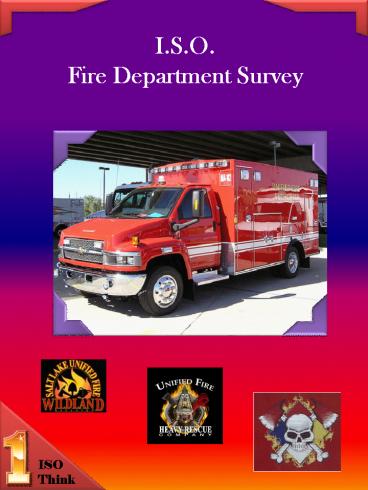Fire Department Survey - PowerPoint PPT Presentation
1 / 26
Title:
Fire Department Survey
Description:
I.S.O. Fire Department Survey A few changes since our last ISO Evaluation ISO Think New Stations Station 108 Big Cottonwood Canyon Station 111 Magna Station 119 in ... – PowerPoint PPT presentation
Number of Views:319
Avg rating:3.0/5.0
Title: Fire Department Survey
1
I.S.O. Fire Department Survey
A few changes since our last ISO Evaluation
ISO Think
2
Facilities
New Stations Station 108 Big Cottonwood
Canyon Station 111 Magna Station 119 in
Emigration Canyon Station 121 Riverton Station
122 in Suncrest Station 123 Herriman
Station Upgrades Station 101 Station 104 Station
106
New Equipment
Seagrave Fire Apparatus, recently delivered 20
units specifically designed to meet the
requirement of the Unified Fire Authority in Salt
Lake City, UT. 16- custom pumpers, 1- 75 quint ,
1- heavy rescue, and 2- Ford F550 brush trucks
have been placed in service. The UFA has ordered
2 additional 75' quints , and a 100' quint!
3
(No Transcript)
4
(No Transcript)
5
Equivalency List Continued
6
(No Transcript)
7
(No Transcript)
8
(No Transcript)
9
(No Transcript)
10
(No Transcript)
11
Pump Tests
Pumper Service Tests Average Interval between
3 Most Recent Tests Maximum Points Credit 1
year 100 2 years 75 3 years 50 4
years 25 5 years 0
NFPA Standard 1911, Standard for Service Tests of
Fire Pump Systems on Fire Apparatus, describes
pumper service tests. A pumper service test is
similar to the certification test described in
NFPA Standard 1901, except that the duration is
reduced to 20 minutes at 150 psi, 10 minutes at
200 psi, and 10 minutes at 250 psi. The overload
test is not a necessary part of the ISO review.
12
Hose Tests
Hose Service Tests Average Interval between 3
Most Recent Tests Maximum Points Credit
250 psi 200 psi 150 psi 1 year 50 37
28 2 years 37 27 18 3 years 25 18 12
4 years 12 9 6 5 years 0 0 0
NFPA Standard 1962, Care, Maintenance and Use of
Fire Hose, describes fire hose tests. When the
hose-test frequency, pressure, or both vary for
2-1/2" and larger hose and for 1-1/2" hose, ISO
prorates the credit using 65 for the 2-1/2" and
larger hose and 35 for the 1-1/2" hose.
Large-diameter hose (LDH) in excess of 3" in
diameter should be tested in accordance with NFPA
1962. The highest test pressure needed for 3"
diameter and smaller hose is 250 psi.
13
NFPA 1962, FIGURE A.5.1.3 Example of a Hose
Record Card.
14
(No Transcript)
15
(No Transcript)
16
(No Transcript)
17
(No Transcript)
18
(No Transcript)
19
(No Transcript)
20
(No Transcript)
21
(No Transcript)
22
NFPA Standards ISO Uses
- NFPA 291 Recommended Practice for Fire Flow
Testing and Marking of Hydrants - NFPA 1001 Standard for Fire Fighter Professional
Qualifications - NFPA 1002 Standard for Fire Apparatus
Driver/Operator Professional Qualifications - NFPA 1021 Standard for Fire Officer Professional
Qualifications - NFPA 1221 Standard for the Installation,
Maintenance, and Use of Emergency Services
Communications Systems - NFPA 1451 Standard for a Fire Service Vehicle
Operations Training Program - NFPA 1500 Standard on Fire Department
Occupational Safety and Health Program - NFPA 1620 Recommended Practice for Pre-Incident
Planning - NFPA 1901 Standard for Automotive Fire Apparatus
- NFPA 1914 Testing Fire Department Aerial Devices
- NFPA 1962 Care, Maintenance and Use of Fire Hose
Contact the Fire Prevention Bureau if you need
NFPA Standards
23
- After the Survey
- After ISO has completed the survey, ISO will meet
briefly with community officials to review the
items for which they have collected information.
The results of the survey will NOT be available
at that meeting. - ISO will then review and analyze the information
and calculate the UFA Public Protection Class. - ISO will notify community officials as soon as we
have determined the PPC. - Generally, ISO will send that notice in a letter
to your community's chief executive with copies
to the fire chief, the water superintendent and
other key individuals involved in the evaluation
process. - With the letter, ISO will include
- A summary of hydrant flow tests
- A summary of the grading results
- A detailed breakdown of the features reviewed
suggestions for improvements - If a community official has questions about the
facts used to determine the PPC, ISO will respond
immediately. If the facts used in developing the
PPC change, ISO will, upon field verification,
revise the classification as appropriate.
24
(No Transcript)
25
(No Transcript)
26
(No Transcript)































